BSOM046: Analyzing Philips' Transition Towards a Circular Economy
VerifiedAdded on 2023/06/10
|14
|3141
|65
Report
AI Summary
This report examines Philips' transition to a circular economy, providing both theoretical and practical perspectives. It begins by defining a circular economy and its seven pillars, then explores the role of circular supply chains and the benefits of this economic model. The report details how Philips integrates circular economy principles into its business operations, highlighting specific products and initiatives in healthcare, lighting, and consumer lifestyle. It also discusses Philips' commitment to renewable energy, waste reduction, and sustainable product design. The analysis includes examples of Philips' refurbished medical products, circular lighting solutions, and innovative business models like "pay-per-lux." The report concludes by emphasizing the social, economic, and environmental benefits derived from Philips' circular economy practices, contributing to a more sustainable and resource-efficient approach to business.
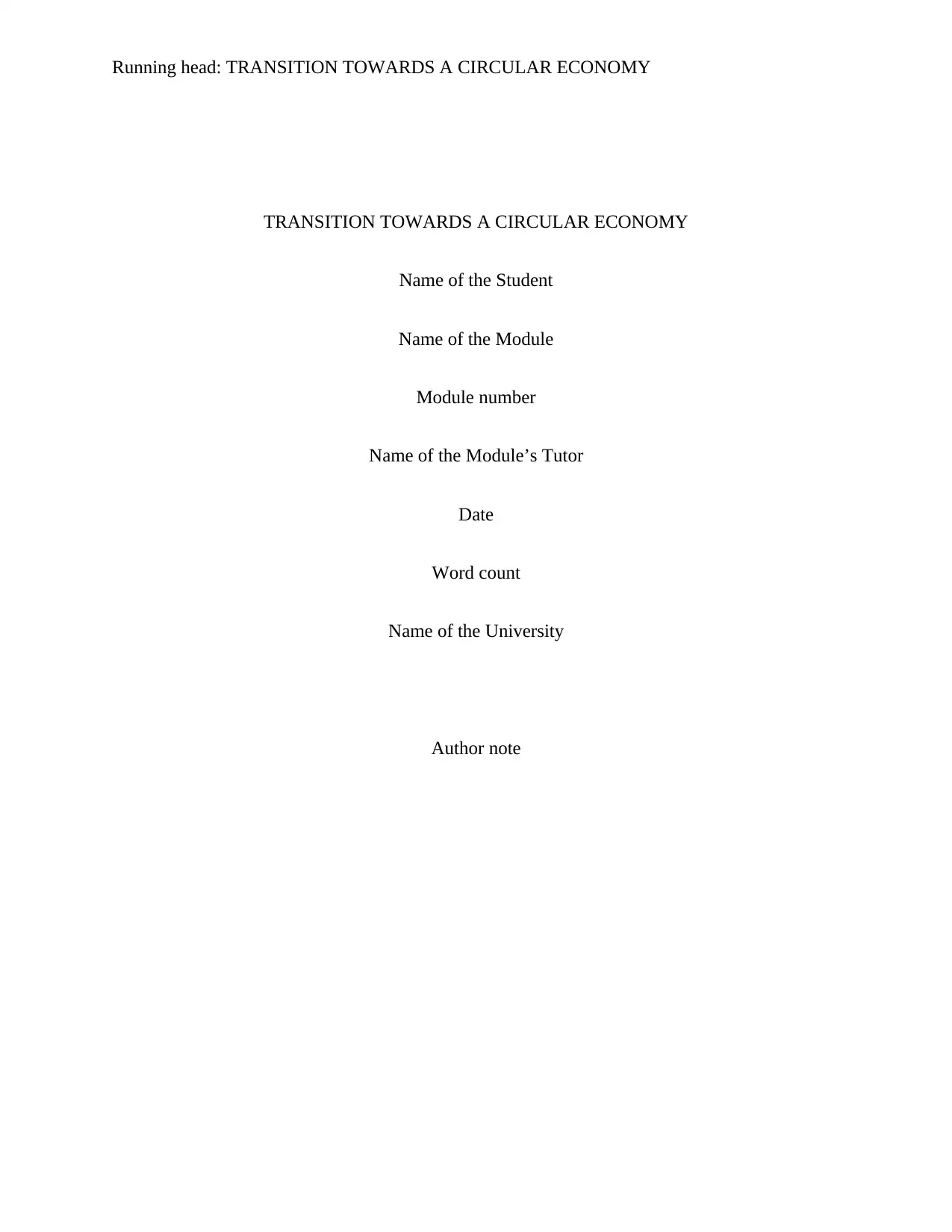
Running head: TRANSITION TOWARDS A CIRCULAR ECONOMY
TRANSITION TOWARDS A CIRCULAR ECONOMY
Name of the Student
Name of the Module
Module number
Name of the Module’s Tutor
Date
Word count
Name of the University
Author note
TRANSITION TOWARDS A CIRCULAR ECONOMY
Name of the Student
Name of the Module
Module number
Name of the Module’s Tutor
Date
Word count
Name of the University
Author note
Paraphrase This Document
Need a fresh take? Get an instant paraphrase of this document with our AI Paraphraser
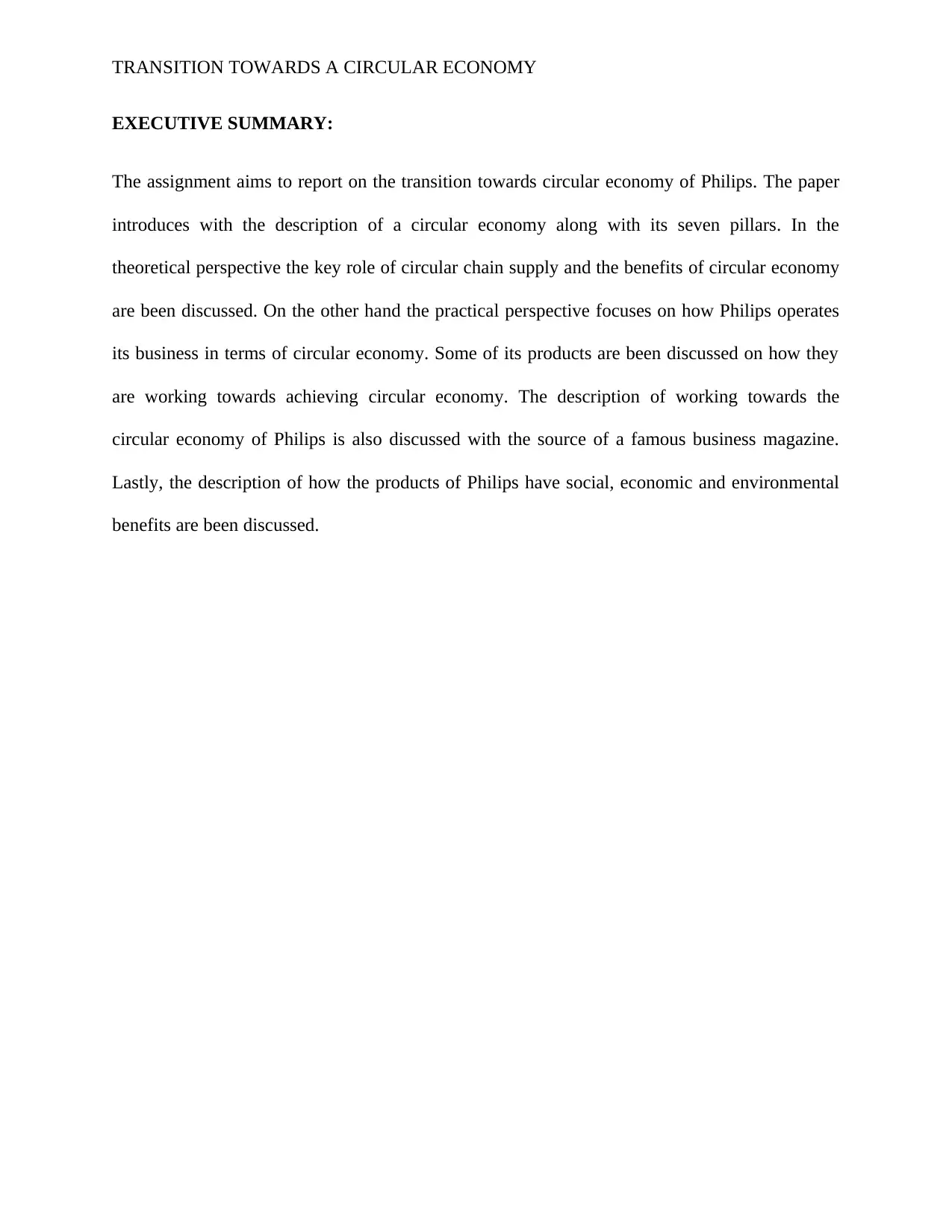
TRANSITION TOWARDS A CIRCULAR ECONOMY
EXECUTIVE SUMMARY:
The assignment aims to report on the transition towards circular economy of Philips. The paper
introduces with the description of a circular economy along with its seven pillars. In the
theoretical perspective the key role of circular chain supply and the benefits of circular economy
are been discussed. On the other hand the practical perspective focuses on how Philips operates
its business in terms of circular economy. Some of its products are been discussed on how they
are working towards achieving circular economy. The description of working towards the
circular economy of Philips is also discussed with the source of a famous business magazine.
Lastly, the description of how the products of Philips have social, economic and environmental
benefits are been discussed.
EXECUTIVE SUMMARY:
The assignment aims to report on the transition towards circular economy of Philips. The paper
introduces with the description of a circular economy along with its seven pillars. In the
theoretical perspective the key role of circular chain supply and the benefits of circular economy
are been discussed. On the other hand the practical perspective focuses on how Philips operates
its business in terms of circular economy. Some of its products are been discussed on how they
are working towards achieving circular economy. The description of working towards the
circular economy of Philips is also discussed with the source of a famous business magazine.
Lastly, the description of how the products of Philips have social, economic and environmental
benefits are been discussed.
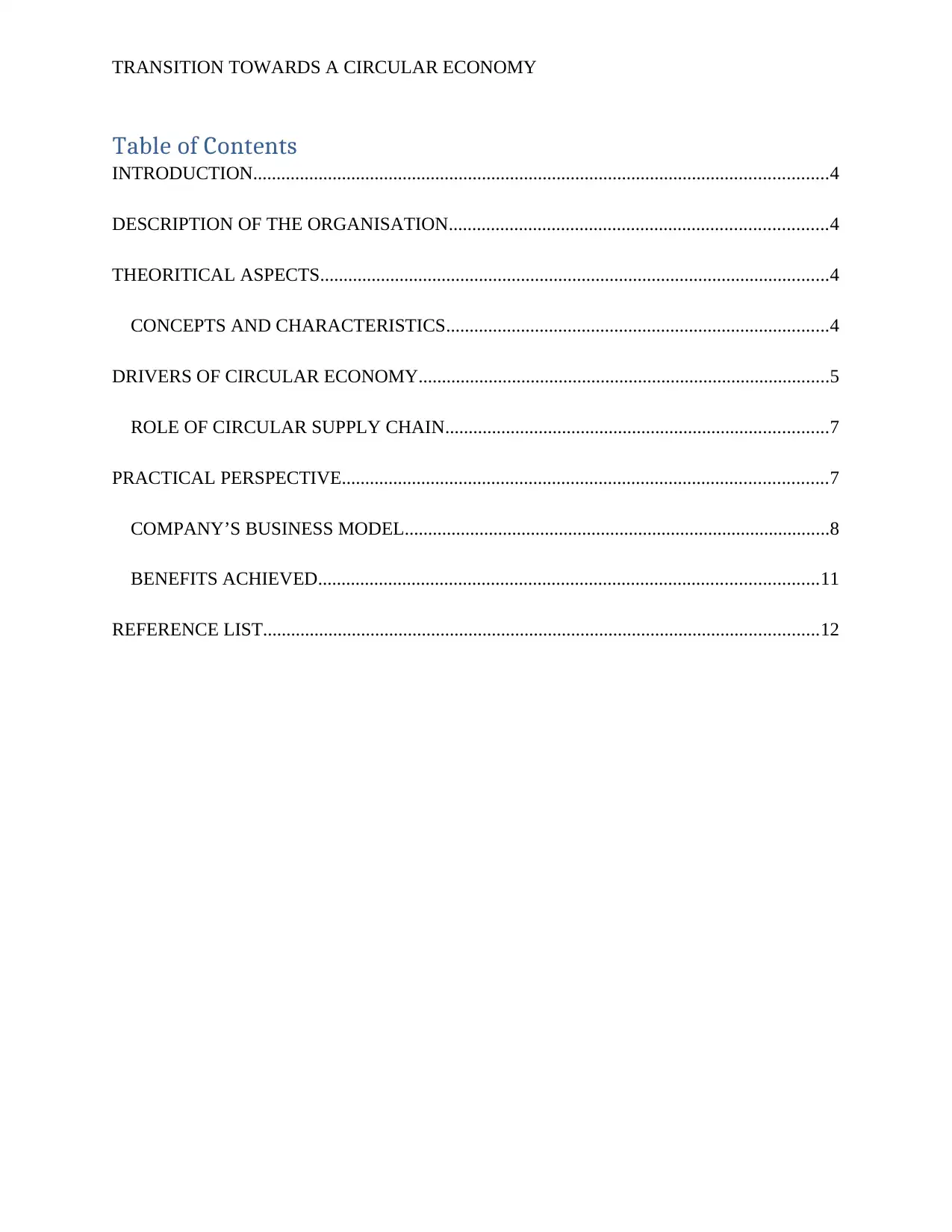
TRANSITION TOWARDS A CIRCULAR ECONOMY
Table of Contents
INTRODUCTION...........................................................................................................................4
DESCRIPTION OF THE ORGANISATION.................................................................................4
THEORITICAL ASPECTS.............................................................................................................4
CONCEPTS AND CHARACTERISTICS..................................................................................4
DRIVERS OF CIRCULAR ECONOMY........................................................................................5
ROLE OF CIRCULAR SUPPLY CHAIN..................................................................................7
PRACTICAL PERSPECTIVE........................................................................................................7
COMPANY’S BUSINESS MODEL...........................................................................................8
BENEFITS ACHIEVED...........................................................................................................11
REFERENCE LIST.......................................................................................................................12
Table of Contents
INTRODUCTION...........................................................................................................................4
DESCRIPTION OF THE ORGANISATION.................................................................................4
THEORITICAL ASPECTS.............................................................................................................4
CONCEPTS AND CHARACTERISTICS..................................................................................4
DRIVERS OF CIRCULAR ECONOMY........................................................................................5
ROLE OF CIRCULAR SUPPLY CHAIN..................................................................................7
PRACTICAL PERSPECTIVE........................................................................................................7
COMPANY’S BUSINESS MODEL...........................................................................................8
BENEFITS ACHIEVED...........................................................................................................11
REFERENCE LIST.......................................................................................................................12
⊘ This is a preview!⊘
Do you want full access?
Subscribe today to unlock all pages.

Trusted by 1+ million students worldwide
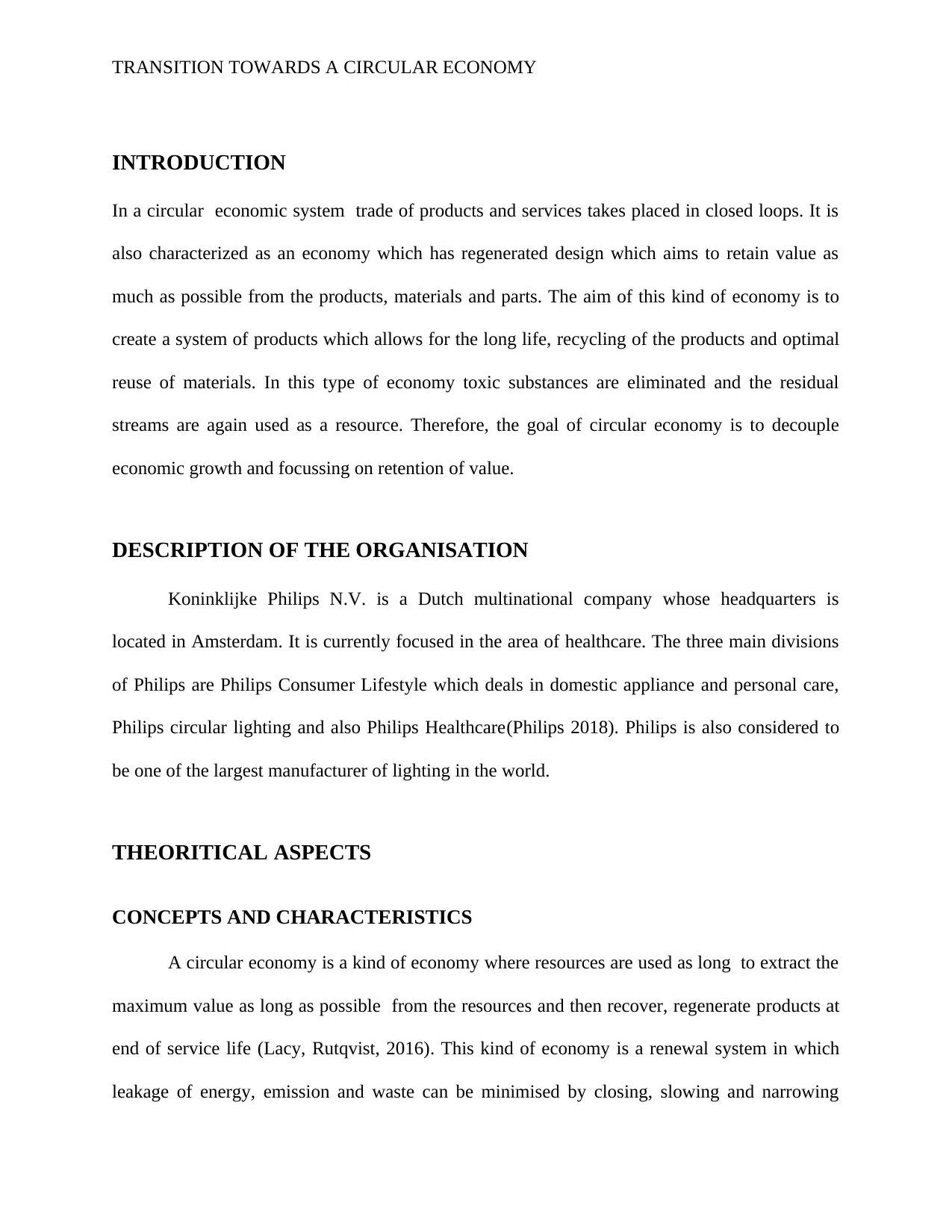
TRANSITION TOWARDS A CIRCULAR ECONOMY
INTRODUCTION
In a circular economic system trade of products and services takes placed in closed loops. It is
also characterized as an economy which has regenerated design which aims to retain value as
much as possible from the products, materials and parts. The aim of this kind of economy is to
create a system of products which allows for the long life, recycling of the products and optimal
reuse of materials. In this type of economy toxic substances are eliminated and the residual
streams are again used as a resource. Therefore, the goal of circular economy is to decouple
economic growth and focussing on retention of value.
DESCRIPTION OF THE ORGANISATION
Koninklijke Philips N.V. is a Dutch multinational company whose headquarters is
located in Amsterdam. It is currently focused in the area of healthcare. The three main divisions
of Philips are Philips Consumer Lifestyle which deals in domestic appliance and personal care,
Philips circular lighting and also Philips Healthcare(Philips 2018). Philips is also considered to
be one of the largest manufacturer of lighting in the world.
THEORITICAL ASPECTS
CONCEPTS AND CHARACTERISTICS
A circular economy is a kind of economy where resources are used as long to extract the
maximum value as long as possible from the resources and then recover, regenerate products at
end of service life (Lacy, Rutqvist, 2016). This kind of economy is a renewal system in which
leakage of energy, emission and waste can be minimised by closing, slowing and narrowing
INTRODUCTION
In a circular economic system trade of products and services takes placed in closed loops. It is
also characterized as an economy which has regenerated design which aims to retain value as
much as possible from the products, materials and parts. The aim of this kind of economy is to
create a system of products which allows for the long life, recycling of the products and optimal
reuse of materials. In this type of economy toxic substances are eliminated and the residual
streams are again used as a resource. Therefore, the goal of circular economy is to decouple
economic growth and focussing on retention of value.
DESCRIPTION OF THE ORGANISATION
Koninklijke Philips N.V. is a Dutch multinational company whose headquarters is
located in Amsterdam. It is currently focused in the area of healthcare. The three main divisions
of Philips are Philips Consumer Lifestyle which deals in domestic appliance and personal care,
Philips circular lighting and also Philips Healthcare(Philips 2018). Philips is also considered to
be one of the largest manufacturer of lighting in the world.
THEORITICAL ASPECTS
CONCEPTS AND CHARACTERISTICS
A circular economy is a kind of economy where resources are used as long to extract the
maximum value as long as possible from the resources and then recover, regenerate products at
end of service life (Lacy, Rutqvist, 2016). This kind of economy is a renewal system in which
leakage of energy, emission and waste can be minimised by closing, slowing and narrowing
Paraphrase This Document
Need a fresh take? Get an instant paraphrase of this document with our AI Paraphraser
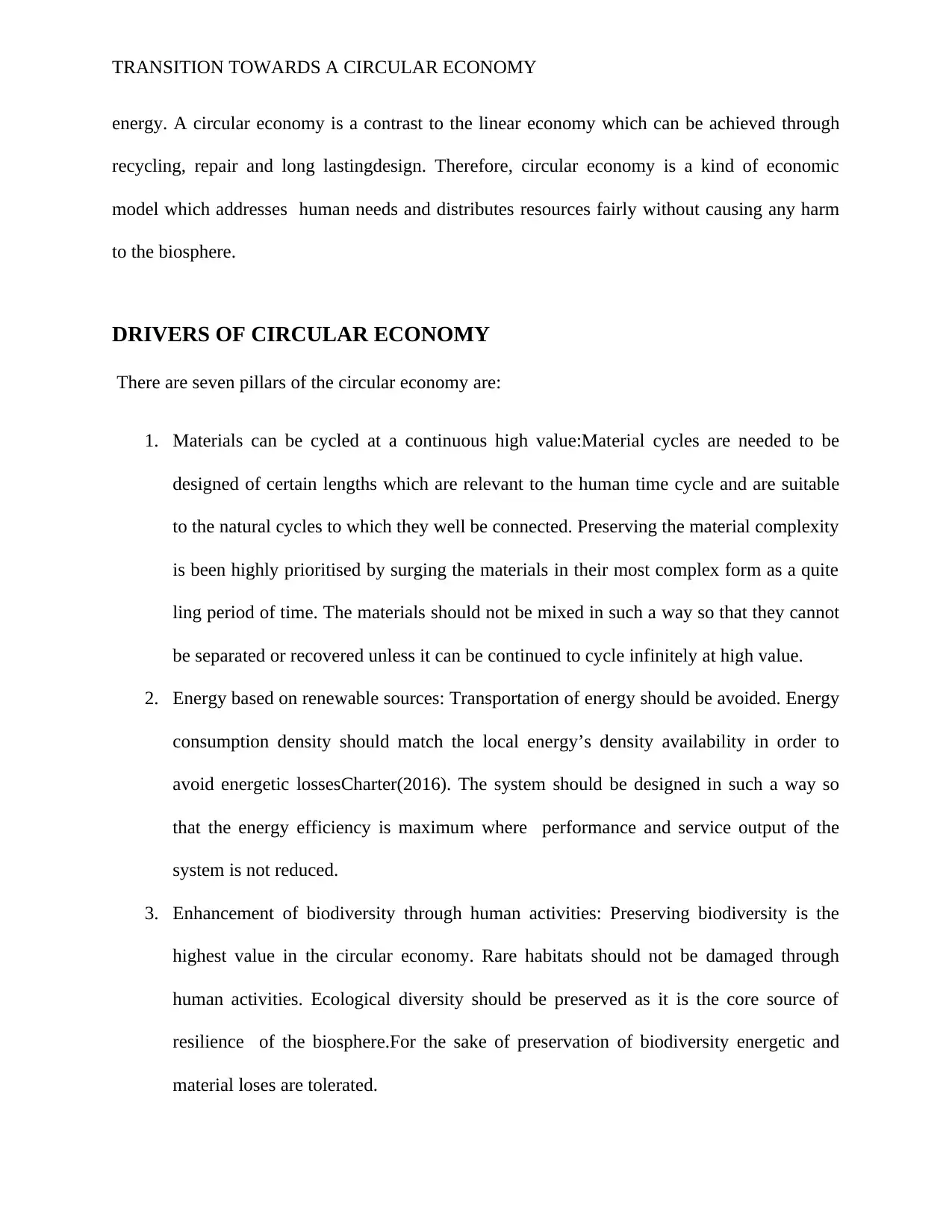
TRANSITION TOWARDS A CIRCULAR ECONOMY
energy. A circular economy is a contrast to the linear economy which can be achieved through
recycling, repair and long lastingdesign. Therefore, circular economy is a kind of economic
model which addresses human needs and distributes resources fairly without causing any harm
to the biosphere.
DRIVERS OF CIRCULAR ECONOMY
There are seven pillars of the circular economy are:
1. Materials can be cycled at a continuous high value:Material cycles are needed to be
designed of certain lengths which are relevant to the human time cycle and are suitable
to the natural cycles to which they well be connected. Preserving the material complexity
is been highly prioritised by surging the materials in their most complex form as a quite
ling period of time. The materials should not be mixed in such a way so that they cannot
be separated or recovered unless it can be continued to cycle infinitely at high value.
2. Energy based on renewable sources: Transportation of energy should be avoided. Energy
consumption density should match the local energy’s density availability in order to
avoid energetic lossesCharter(2016). The system should be designed in such a way so
that the energy efficiency is maximum where performance and service output of the
system is not reduced.
3. Enhancement of biodiversity through human activities: Preserving biodiversity is the
highest value in the circular economy. Rare habitats should not be damaged through
human activities. Ecological diversity should be preserved as it is the core source of
resilience of the biosphere.For the sake of preservation of biodiversity energetic and
material loses are tolerated.
energy. A circular economy is a contrast to the linear economy which can be achieved through
recycling, repair and long lastingdesign. Therefore, circular economy is a kind of economic
model which addresses human needs and distributes resources fairly without causing any harm
to the biosphere.
DRIVERS OF CIRCULAR ECONOMY
There are seven pillars of the circular economy are:
1. Materials can be cycled at a continuous high value:Material cycles are needed to be
designed of certain lengths which are relevant to the human time cycle and are suitable
to the natural cycles to which they well be connected. Preserving the material complexity
is been highly prioritised by surging the materials in their most complex form as a quite
ling period of time. The materials should not be mixed in such a way so that they cannot
be separated or recovered unless it can be continued to cycle infinitely at high value.
2. Energy based on renewable sources: Transportation of energy should be avoided. Energy
consumption density should match the local energy’s density availability in order to
avoid energetic lossesCharter(2016). The system should be designed in such a way so
that the energy efficiency is maximum where performance and service output of the
system is not reduced.
3. Enhancement of biodiversity through human activities: Preserving biodiversity is the
highest value in the circular economy. Rare habitats should not be damaged through
human activities. Ecological diversity should be preserved as it is the core source of
resilience of the biosphere.For the sake of preservation of biodiversity energetic and
material loses are tolerated.
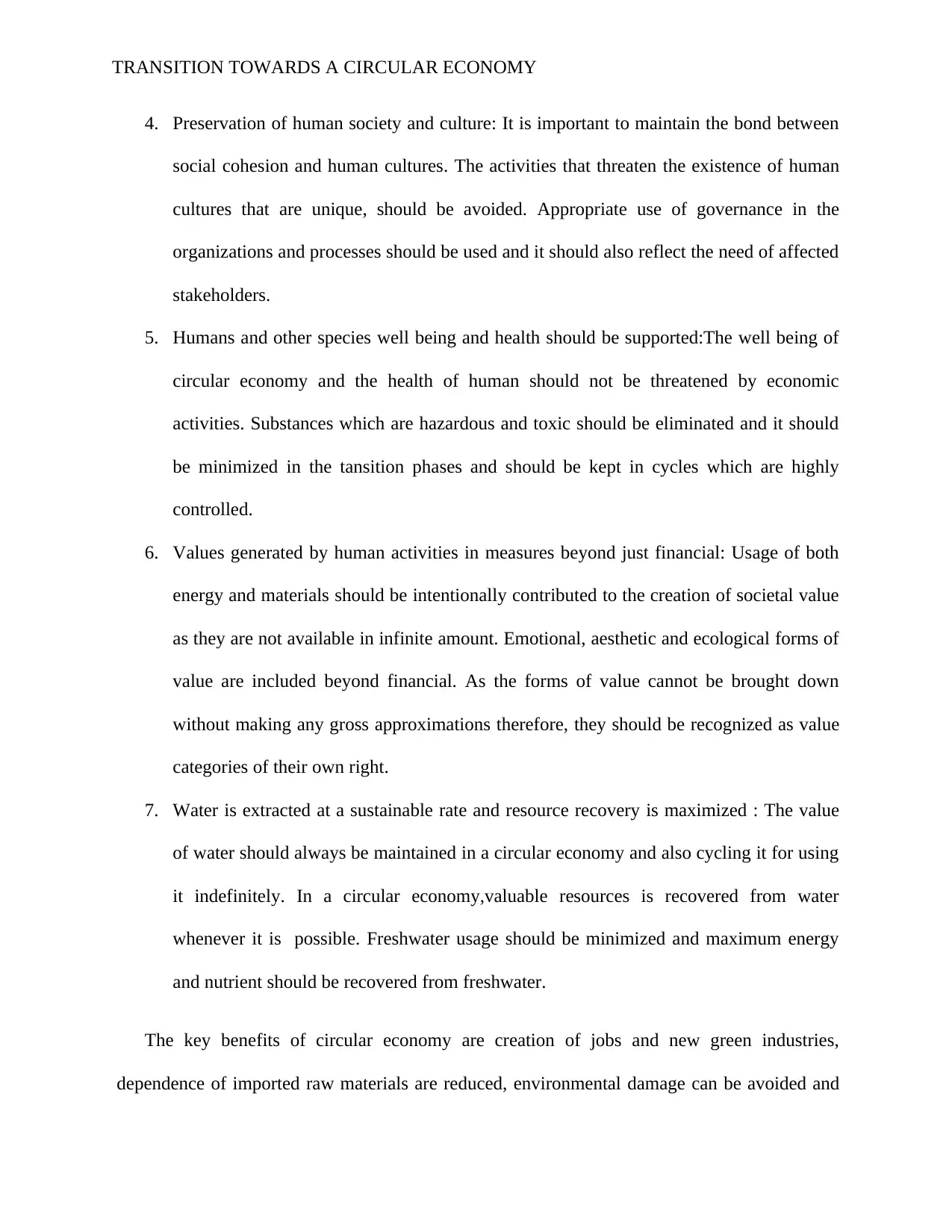
TRANSITION TOWARDS A CIRCULAR ECONOMY
4. Preservation of human society and culture: It is important to maintain the bond between
social cohesion and human cultures. The activities that threaten the existence of human
cultures that are unique, should be avoided. Appropriate use of governance in the
organizations and processes should be used and it should also reflect the need of affected
stakeholders.
5. Humans and other species well being and health should be supported:The well being of
circular economy and the health of human should not be threatened by economic
activities. Substances which are hazardous and toxic should be eliminated and it should
be minimized in the tansition phases and should be kept in cycles which are highly
controlled.
6. Values generated by human activities in measures beyond just financial: Usage of both
energy and materials should be intentionally contributed to the creation of societal value
as they are not available in infinite amount. Emotional, aesthetic and ecological forms of
value are included beyond financial. As the forms of value cannot be brought down
without making any gross approximations therefore, they should be recognized as value
categories of their own right.
7. Water is extracted at a sustainable rate and resource recovery is maximized : The value
of water should always be maintained in a circular economy and also cycling it for using
it indefinitely. In a circular economy,valuable resources is recovered from water
whenever it is possible. Freshwater usage should be minimized and maximum energy
and nutrient should be recovered from freshwater.
The key benefits of circular economy are creation of jobs and new green industries,
dependence of imported raw materials are reduced, environmental damage can be avoided and
4. Preservation of human society and culture: It is important to maintain the bond between
social cohesion and human cultures. The activities that threaten the existence of human
cultures that are unique, should be avoided. Appropriate use of governance in the
organizations and processes should be used and it should also reflect the need of affected
stakeholders.
5. Humans and other species well being and health should be supported:The well being of
circular economy and the health of human should not be threatened by economic
activities. Substances which are hazardous and toxic should be eliminated and it should
be minimized in the tansition phases and should be kept in cycles which are highly
controlled.
6. Values generated by human activities in measures beyond just financial: Usage of both
energy and materials should be intentionally contributed to the creation of societal value
as they are not available in infinite amount. Emotional, aesthetic and ecological forms of
value are included beyond financial. As the forms of value cannot be brought down
without making any gross approximations therefore, they should be recognized as value
categories of their own right.
7. Water is extracted at a sustainable rate and resource recovery is maximized : The value
of water should always be maintained in a circular economy and also cycling it for using
it indefinitely. In a circular economy,valuable resources is recovered from water
whenever it is possible. Freshwater usage should be minimized and maximum energy
and nutrient should be recovered from freshwater.
The key benefits of circular economy are creation of jobs and new green industries,
dependence of imported raw materials are reduced, environmental damage can be avoided and
⊘ This is a preview!⊘
Do you want full access?
Subscribe today to unlock all pages.

Trusted by 1+ million students worldwide
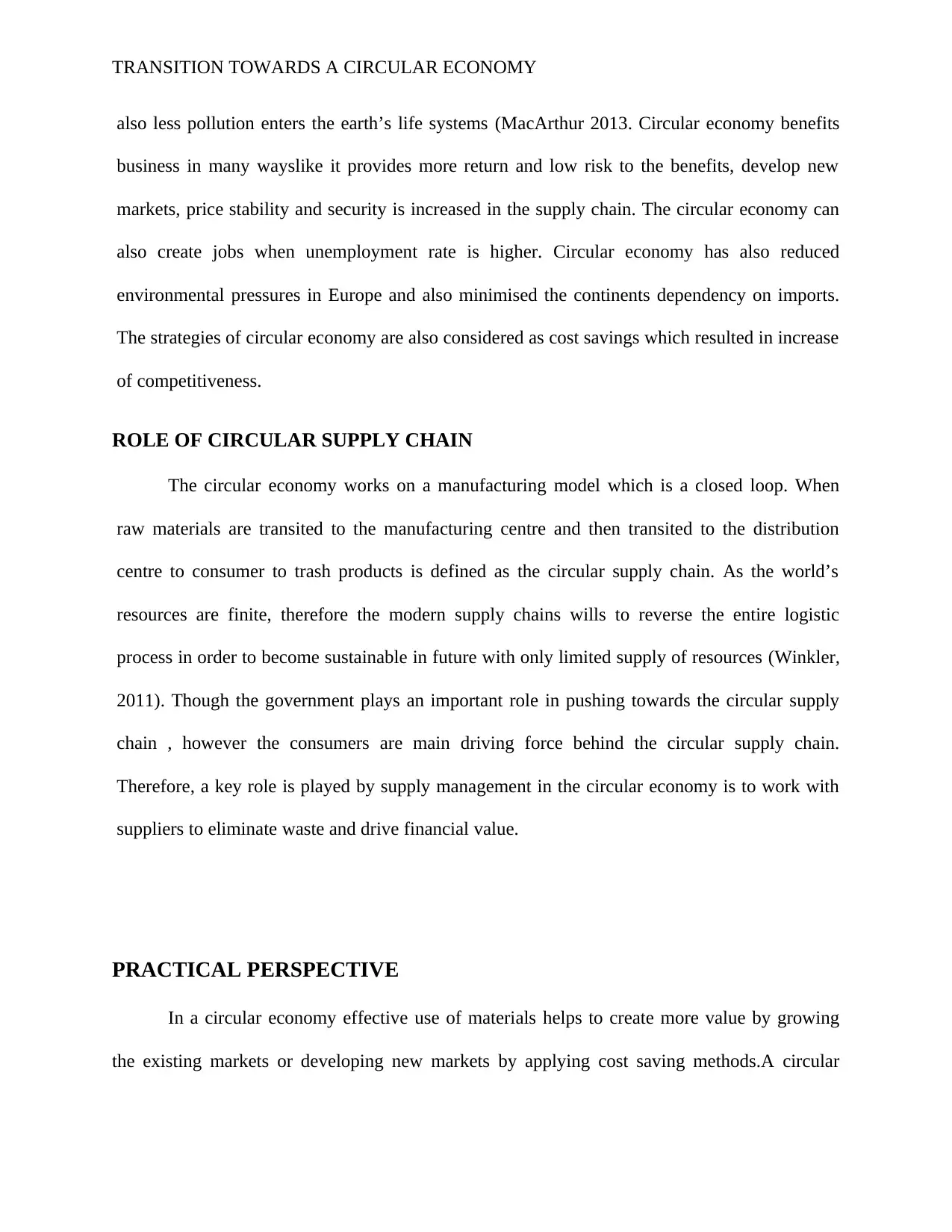
TRANSITION TOWARDS A CIRCULAR ECONOMY
also less pollution enters the earth’s life systems (MacArthur 2013. Circular economy benefits
business in many wayslike it provides more return and low risk to the benefits, develop new
markets, price stability and security is increased in the supply chain. The circular economy can
also create jobs when unemployment rate is higher. Circular economy has also reduced
environmental pressures in Europe and also minimised the continents dependency on imports.
The strategies of circular economy are also considered as cost savings which resulted in increase
of competitiveness.
ROLE OF CIRCULAR SUPPLY CHAIN
The circular economy works on a manufacturing model which is a closed loop. When
raw materials are transited to the manufacturing centre and then transited to the distribution
centre to consumer to trash products is defined as the circular supply chain. As the world’s
resources are finite, therefore the modern supply chains wills to reverse the entire logistic
process in order to become sustainable in future with only limited supply of resources (Winkler,
2011). Though the government plays an important role in pushing towards the circular supply
chain , however the consumers are main driving force behind the circular supply chain.
Therefore, a key role is played by supply management in the circular economy is to work with
suppliers to eliminate waste and drive financial value.
PRACTICAL PERSPECTIVE
In a circular economy effective use of materials helps to create more value by growing
the existing markets or developing new markets by applying cost saving methods.A circular
also less pollution enters the earth’s life systems (MacArthur 2013. Circular economy benefits
business in many wayslike it provides more return and low risk to the benefits, develop new
markets, price stability and security is increased in the supply chain. The circular economy can
also create jobs when unemployment rate is higher. Circular economy has also reduced
environmental pressures in Europe and also minimised the continents dependency on imports.
The strategies of circular economy are also considered as cost savings which resulted in increase
of competitiveness.
ROLE OF CIRCULAR SUPPLY CHAIN
The circular economy works on a manufacturing model which is a closed loop. When
raw materials are transited to the manufacturing centre and then transited to the distribution
centre to consumer to trash products is defined as the circular supply chain. As the world’s
resources are finite, therefore the modern supply chains wills to reverse the entire logistic
process in order to become sustainable in future with only limited supply of resources (Winkler,
2011). Though the government plays an important role in pushing towards the circular supply
chain , however the consumers are main driving force behind the circular supply chain.
Therefore, a key role is played by supply management in the circular economy is to work with
suppliers to eliminate waste and drive financial value.
PRACTICAL PERSPECTIVE
In a circular economy effective use of materials helps to create more value by growing
the existing markets or developing new markets by applying cost saving methods.A circular
Paraphrase This Document
Need a fresh take? Get an instant paraphrase of this document with our AI Paraphraser
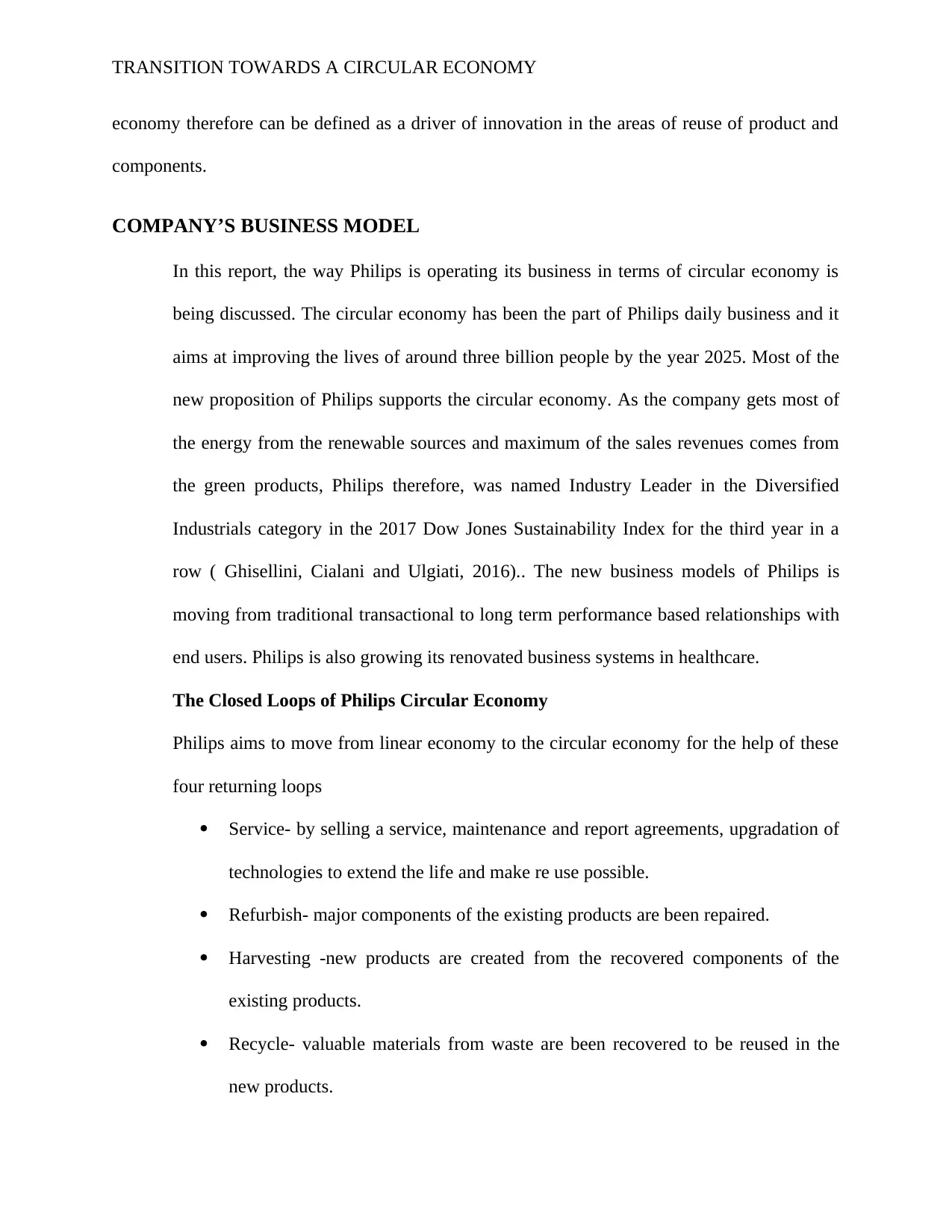
TRANSITION TOWARDS A CIRCULAR ECONOMY
economy therefore can be defined as a driver of innovation in the areas of reuse of product and
components.
COMPANY’S BUSINESS MODEL
In this report, the way Philips is operating its business in terms of circular economy is
being discussed. The circular economy has been the part of Philips daily business and it
aims at improving the lives of around three billion people by the year 2025. Most of the
new proposition of Philips supports the circular economy. As the company gets most of
the energy from the renewable sources and maximum of the sales revenues comes from
the green products, Philips therefore, was named Industry Leader in the Diversified
Industrials category in the 2017 Dow Jones Sustainability Index for the third year in a
row ( Ghisellini, Cialani and Ulgiati, 2016).. The new business models of Philips is
moving from traditional transactional to long term performance based relationships with
end users. Philips is also growing its renovated business systems in healthcare.
The Closed Loops of Philips Circular Economy
Philips aims to move from linear economy to the circular economy for the help of these
four returning loops
Service- by selling a service, maintenance and report agreements, upgradation of
technologies to extend the life and make re use possible.
Refurbish- major components of the existing products are been repaired.
Harvesting -new products are created from the recovered components of the
existing products.
Recycle- valuable materials from waste are been recovered to be reused in the
new products.
economy therefore can be defined as a driver of innovation in the areas of reuse of product and
components.
COMPANY’S BUSINESS MODEL
In this report, the way Philips is operating its business in terms of circular economy is
being discussed. The circular economy has been the part of Philips daily business and it
aims at improving the lives of around three billion people by the year 2025. Most of the
new proposition of Philips supports the circular economy. As the company gets most of
the energy from the renewable sources and maximum of the sales revenues comes from
the green products, Philips therefore, was named Industry Leader in the Diversified
Industrials category in the 2017 Dow Jones Sustainability Index for the third year in a
row ( Ghisellini, Cialani and Ulgiati, 2016).. The new business models of Philips is
moving from traditional transactional to long term performance based relationships with
end users. Philips is also growing its renovated business systems in healthcare.
The Closed Loops of Philips Circular Economy
Philips aims to move from linear economy to the circular economy for the help of these
four returning loops
Service- by selling a service, maintenance and report agreements, upgradation of
technologies to extend the life and make re use possible.
Refurbish- major components of the existing products are been repaired.
Harvesting -new products are created from the recovered components of the
existing products.
Recycle- valuable materials from waste are been recovered to be reused in the
new products.
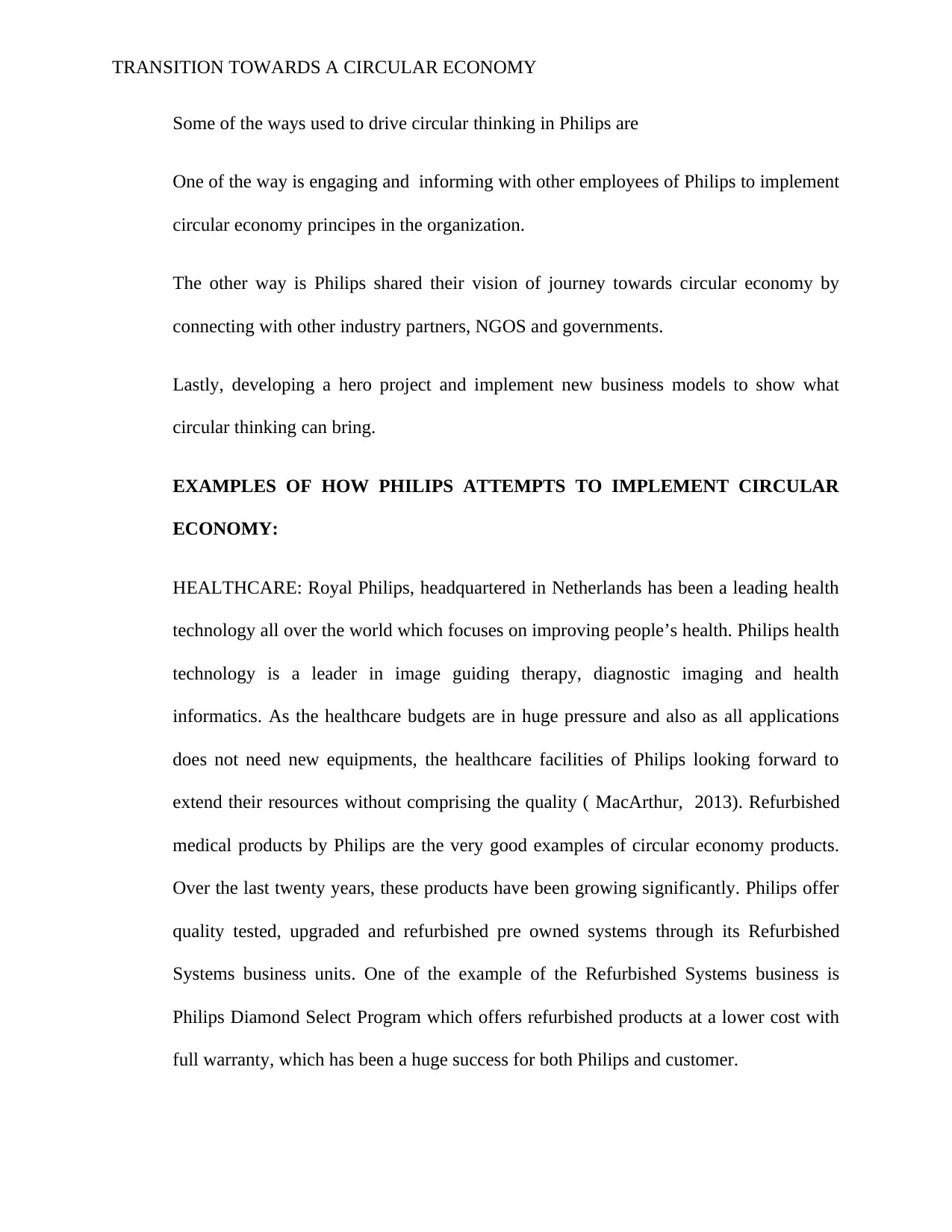
TRANSITION TOWARDS A CIRCULAR ECONOMY
Some of the ways used to drive circular thinking in Philips are
One of the way is engaging and informing with other employees of Philips to implement
circular economy principes in the organization.
The other way is Philips shared their vision of journey towards circular economy by
connecting with other industry partners, NGOS and governments.
Lastly, developing a hero project and implement new business models to show what
circular thinking can bring.
EXAMPLES OF HOW PHILIPS ATTEMPTS TO IMPLEMENT CIRCULAR
ECONOMY:
HEALTHCARE: Royal Philips, headquartered in Netherlands has been a leading health
technology all over the world which focuses on improving people’s health. Philips health
technology is a leader in image guiding therapy, diagnostic imaging and health
informatics. As the healthcare budgets are in huge pressure and also as all applications
does not need new equipments, the healthcare facilities of Philips looking forward to
extend their resources without comprising the quality ( MacArthur, 2013). Refurbished
medical products by Philips are the very good examples of circular economy products.
Over the last twenty years, these products have been growing significantly. Philips offer
quality tested, upgraded and refurbished pre owned systems through its Refurbished
Systems business units. One of the example of the Refurbished Systems business is
Philips Diamond Select Program which offers refurbished products at a lower cost with
full warranty, which has been a huge success for both Philips and customer.
Some of the ways used to drive circular thinking in Philips are
One of the way is engaging and informing with other employees of Philips to implement
circular economy principes in the organization.
The other way is Philips shared their vision of journey towards circular economy by
connecting with other industry partners, NGOS and governments.
Lastly, developing a hero project and implement new business models to show what
circular thinking can bring.
EXAMPLES OF HOW PHILIPS ATTEMPTS TO IMPLEMENT CIRCULAR
ECONOMY:
HEALTHCARE: Royal Philips, headquartered in Netherlands has been a leading health
technology all over the world which focuses on improving people’s health. Philips health
technology is a leader in image guiding therapy, diagnostic imaging and health
informatics. As the healthcare budgets are in huge pressure and also as all applications
does not need new equipments, the healthcare facilities of Philips looking forward to
extend their resources without comprising the quality ( MacArthur, 2013). Refurbished
medical products by Philips are the very good examples of circular economy products.
Over the last twenty years, these products have been growing significantly. Philips offer
quality tested, upgraded and refurbished pre owned systems through its Refurbished
Systems business units. One of the example of the Refurbished Systems business is
Philips Diamond Select Program which offers refurbished products at a lower cost with
full warranty, which has been a huge success for both Philips and customer.
⊘ This is a preview!⊘
Do you want full access?
Subscribe today to unlock all pages.

Trusted by 1+ million students worldwide
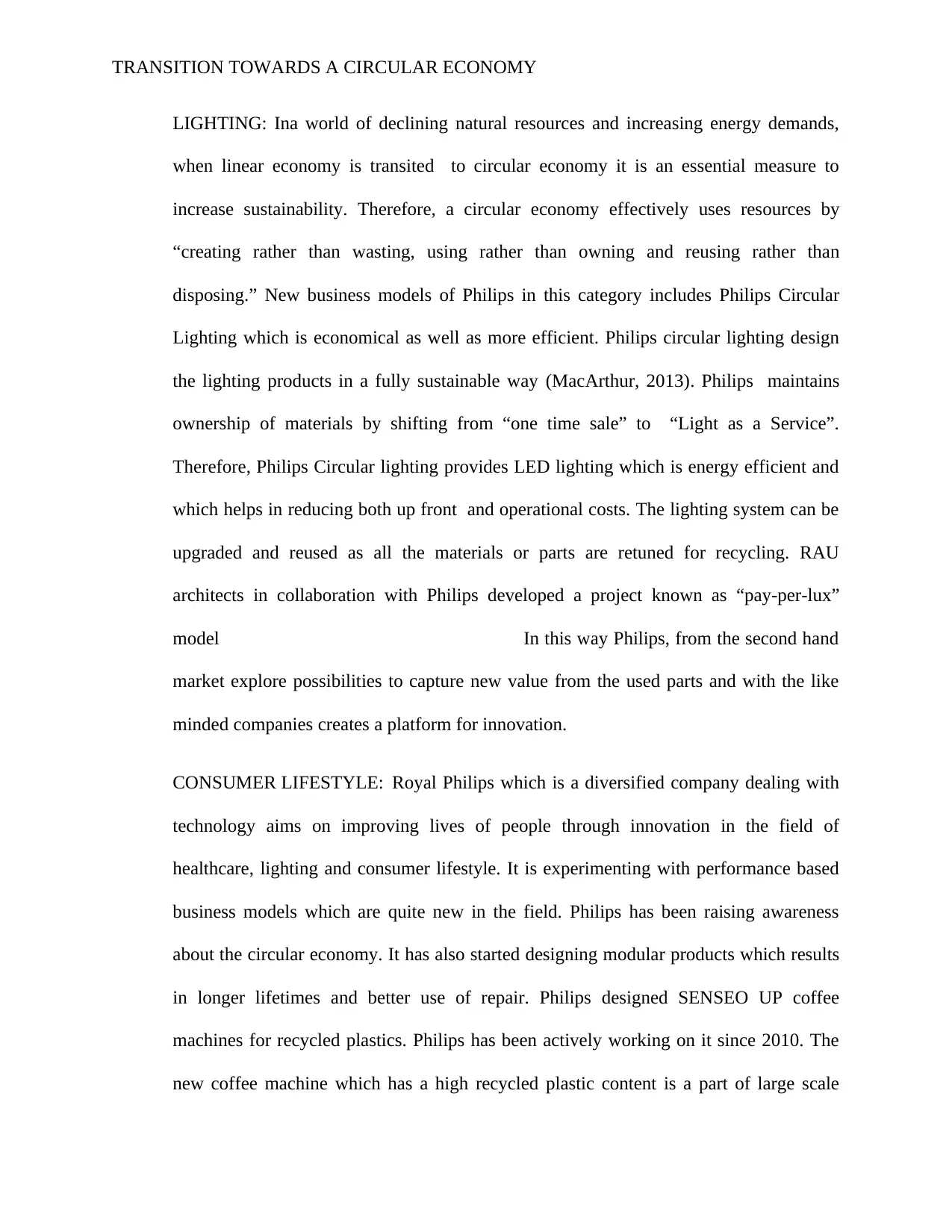
TRANSITION TOWARDS A CIRCULAR ECONOMY
LIGHTING: Ina world of declining natural resources and increasing energy demands,
when linear economy is transited to circular economy it is an essential measure to
increase sustainability. Therefore, a circular economy effectively uses resources by
“creating rather than wasting, using rather than owning and reusing rather than
disposing.” New business models of Philips in this category includes Philips Circular
Lighting which is economical as well as more efficient. Philips circular lighting design
the lighting products in a fully sustainable way (MacArthur, 2013). Philips maintains
ownership of materials by shifting from “one time sale” to “Light as a Service”.
Therefore, Philips Circular lighting provides LED lighting which is energy efficient and
which helps in reducing both up front and operational costs. The lighting system can be
upgraded and reused as all the materials or parts are retuned for recycling. RAU
architects in collaboration with Philips developed a project known as “pay-per-lux”
model In this way Philips, from the second hand
market explore possibilities to capture new value from the used parts and with the like
minded companies creates a platform for innovation.
CONSUMER LIFESTYLE: Royal Philips which is a diversified company dealing with
technology aims on improving lives of people through innovation in the field of
healthcare, lighting and consumer lifestyle. It is experimenting with performance based
business models which are quite new in the field. Philips has been raising awareness
about the circular economy. It has also started designing modular products which results
in longer lifetimes and better use of repair. Philips designed SENSEO UP coffee
machines for recycled plastics. Philips has been actively working on it since 2010. The
new coffee machine which has a high recycled plastic content is a part of large scale
LIGHTING: Ina world of declining natural resources and increasing energy demands,
when linear economy is transited to circular economy it is an essential measure to
increase sustainability. Therefore, a circular economy effectively uses resources by
“creating rather than wasting, using rather than owning and reusing rather than
disposing.” New business models of Philips in this category includes Philips Circular
Lighting which is economical as well as more efficient. Philips circular lighting design
the lighting products in a fully sustainable way (MacArthur, 2013). Philips maintains
ownership of materials by shifting from “one time sale” to “Light as a Service”.
Therefore, Philips Circular lighting provides LED lighting which is energy efficient and
which helps in reducing both up front and operational costs. The lighting system can be
upgraded and reused as all the materials or parts are retuned for recycling. RAU
architects in collaboration with Philips developed a project known as “pay-per-lux”
model In this way Philips, from the second hand
market explore possibilities to capture new value from the used parts and with the like
minded companies creates a platform for innovation.
CONSUMER LIFESTYLE: Royal Philips which is a diversified company dealing with
technology aims on improving lives of people through innovation in the field of
healthcare, lighting and consumer lifestyle. It is experimenting with performance based
business models which are quite new in the field. Philips has been raising awareness
about the circular economy. It has also started designing modular products which results
in longer lifetimes and better use of repair. Philips designed SENSEO UP coffee
machines for recycled plastics. Philips has been actively working on it since 2010. The
new coffee machine which has a high recycled plastic content is a part of large scale
Paraphrase This Document
Need a fresh take? Get an instant paraphrase of this document with our AI Paraphraser
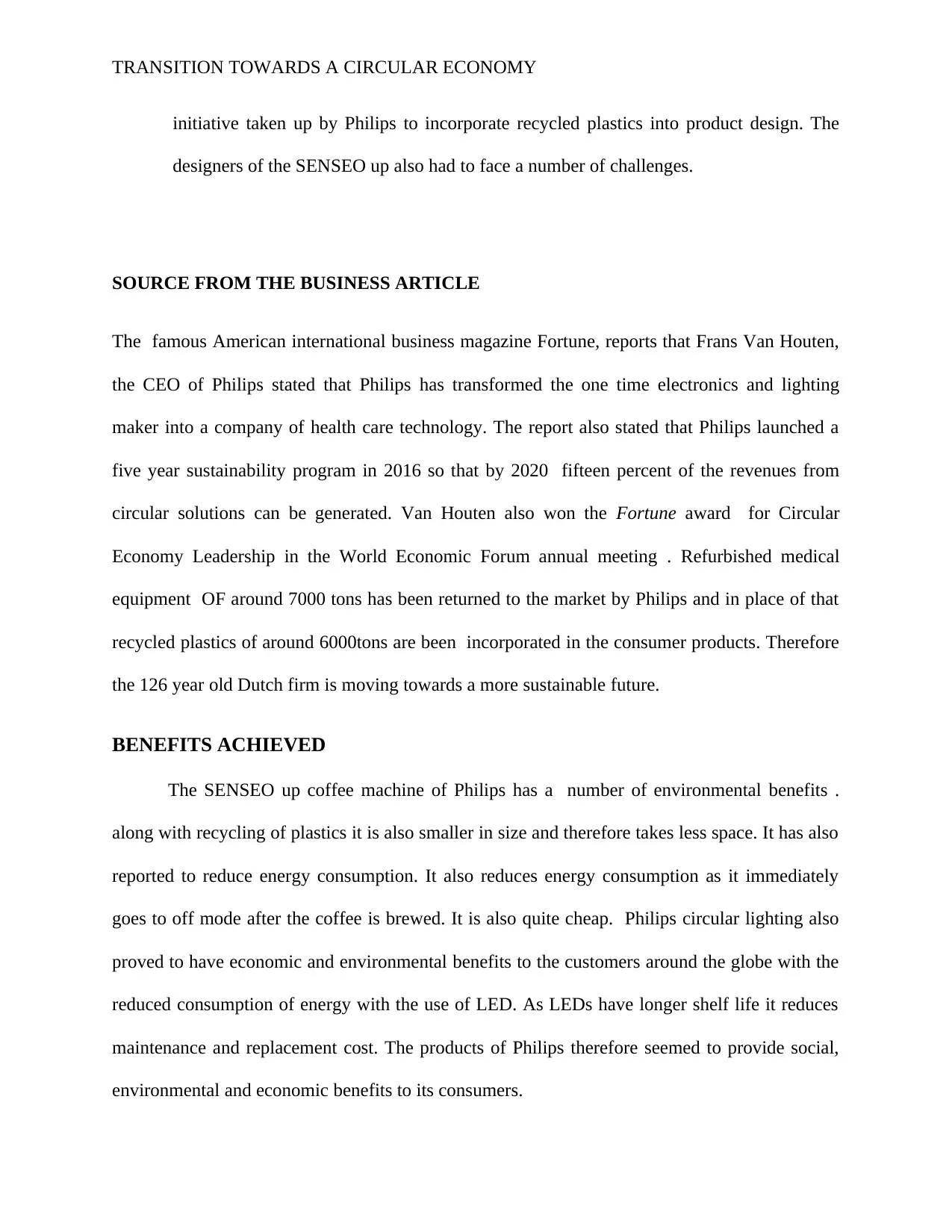
TRANSITION TOWARDS A CIRCULAR ECONOMY
initiative taken up by Philips to incorporate recycled plastics into product design. The
designers of the SENSEO up also had to face a number of challenges.
SOURCE FROM THE BUSINESS ARTICLE
The famous American international business magazine Fortune, reports that Frans Van Houten,
the CEO of Philips stated that Philips has transformed the one time electronics and lighting
maker into a company of health care technology. The report also stated that Philips launched a
five year sustainability program in 2016 so that by 2020 fifteen percent of the revenues from
circular solutions can be generated. Van Houten also won the Fortune award for Circular
Economy Leadership in the World Economic Forum annual meeting . Refurbished medical
equipment OF around 7000 tons has been returned to the market by Philips and in place of that
recycled plastics of around 6000tons are been incorporated in the consumer products. Therefore
the 126 year old Dutch firm is moving towards a more sustainable future.
BENEFITS ACHIEVED
The SENSEO up coffee machine of Philips has a number of environmental benefits .
along with recycling of plastics it is also smaller in size and therefore takes less space. It has also
reported to reduce energy consumption. It also reduces energy consumption as it immediately
goes to off mode after the coffee is brewed. It is also quite cheap. Philips circular lighting also
proved to have economic and environmental benefits to the customers around the globe with the
reduced consumption of energy with the use of LED. As LEDs have longer shelf life it reduces
maintenance and replacement cost. The products of Philips therefore seemed to provide social,
environmental and economic benefits to its consumers.
initiative taken up by Philips to incorporate recycled plastics into product design. The
designers of the SENSEO up also had to face a number of challenges.
SOURCE FROM THE BUSINESS ARTICLE
The famous American international business magazine Fortune, reports that Frans Van Houten,
the CEO of Philips stated that Philips has transformed the one time electronics and lighting
maker into a company of health care technology. The report also stated that Philips launched a
five year sustainability program in 2016 so that by 2020 fifteen percent of the revenues from
circular solutions can be generated. Van Houten also won the Fortune award for Circular
Economy Leadership in the World Economic Forum annual meeting . Refurbished medical
equipment OF around 7000 tons has been returned to the market by Philips and in place of that
recycled plastics of around 6000tons are been incorporated in the consumer products. Therefore
the 126 year old Dutch firm is moving towards a more sustainable future.
BENEFITS ACHIEVED
The SENSEO up coffee machine of Philips has a number of environmental benefits .
along with recycling of plastics it is also smaller in size and therefore takes less space. It has also
reported to reduce energy consumption. It also reduces energy consumption as it immediately
goes to off mode after the coffee is brewed. It is also quite cheap. Philips circular lighting also
proved to have economic and environmental benefits to the customers around the globe with the
reduced consumption of energy with the use of LED. As LEDs have longer shelf life it reduces
maintenance and replacement cost. The products of Philips therefore seemed to provide social,
environmental and economic benefits to its consumers.
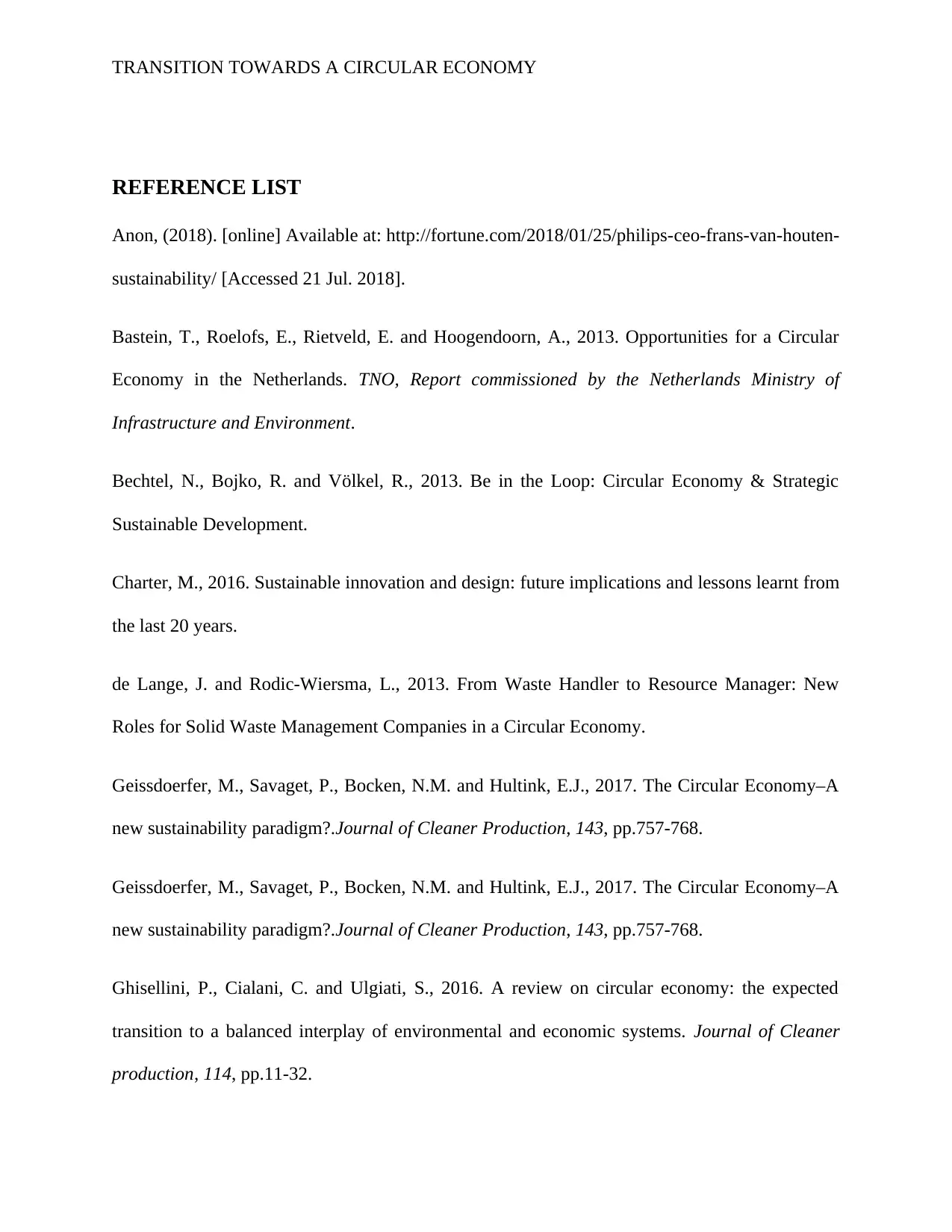
TRANSITION TOWARDS A CIRCULAR ECONOMY
REFERENCE LIST
Anon, (2018). [online] Available at: http://fortune.com/2018/01/25/philips-ceo-frans-van-houten-
sustainability/ [Accessed 21 Jul. 2018].
Bastein, T., Roelofs, E., Rietveld, E. and Hoogendoorn, A., 2013. Opportunities for a Circular
Economy in the Netherlands. TNO, Report commissioned by the Netherlands Ministry of
Infrastructure and Environment.
Bechtel, N., Bojko, R. and Völkel, R., 2013. Be in the Loop: Circular Economy & Strategic
Sustainable Development.
Charter, M., 2016. Sustainable innovation and design: future implications and lessons learnt from
the last 20 years.
de Lange, J. and Rodic-Wiersma, L., 2013. From Waste Handler to Resource Manager: New
Roles for Solid Waste Management Companies in a Circular Economy.
Geissdoerfer, M., Savaget, P., Bocken, N.M. and Hultink, E.J., 2017. The Circular Economy–A
new sustainability paradigm?.Journal of Cleaner Production, 143, pp.757-768.
Geissdoerfer, M., Savaget, P., Bocken, N.M. and Hultink, E.J., 2017. The Circular Economy–A
new sustainability paradigm?.Journal of Cleaner Production, 143, pp.757-768.
Ghisellini, P., Cialani, C. and Ulgiati, S., 2016. A review on circular economy: the expected
transition to a balanced interplay of environmental and economic systems. Journal of Cleaner
production, 114, pp.11-32.
REFERENCE LIST
Anon, (2018). [online] Available at: http://fortune.com/2018/01/25/philips-ceo-frans-van-houten-
sustainability/ [Accessed 21 Jul. 2018].
Bastein, T., Roelofs, E., Rietveld, E. and Hoogendoorn, A., 2013. Opportunities for a Circular
Economy in the Netherlands. TNO, Report commissioned by the Netherlands Ministry of
Infrastructure and Environment.
Bechtel, N., Bojko, R. and Völkel, R., 2013. Be in the Loop: Circular Economy & Strategic
Sustainable Development.
Charter, M., 2016. Sustainable innovation and design: future implications and lessons learnt from
the last 20 years.
de Lange, J. and Rodic-Wiersma, L., 2013. From Waste Handler to Resource Manager: New
Roles for Solid Waste Management Companies in a Circular Economy.
Geissdoerfer, M., Savaget, P., Bocken, N.M. and Hultink, E.J., 2017. The Circular Economy–A
new sustainability paradigm?.Journal of Cleaner Production, 143, pp.757-768.
Geissdoerfer, M., Savaget, P., Bocken, N.M. and Hultink, E.J., 2017. The Circular Economy–A
new sustainability paradigm?.Journal of Cleaner Production, 143, pp.757-768.
Ghisellini, P., Cialani, C. and Ulgiati, S., 2016. A review on circular economy: the expected
transition to a balanced interplay of environmental and economic systems. Journal of Cleaner
production, 114, pp.11-32.
⊘ This is a preview!⊘
Do you want full access?
Subscribe today to unlock all pages.

Trusted by 1+ million students worldwide
1 out of 14
Related Documents
Your All-in-One AI-Powered Toolkit for Academic Success.
+13062052269
info@desklib.com
Available 24*7 on WhatsApp / Email
![[object Object]](/_next/static/media/star-bottom.7253800d.svg)
Unlock your academic potential
Copyright © 2020–2025 A2Z Services. All Rights Reserved. Developed and managed by ZUCOL.





